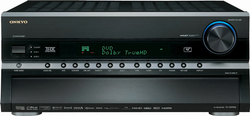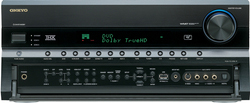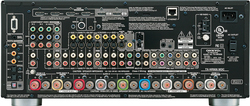Introduction
Onkyo has broken new ground by introducing two receivers to be the first in the world with ISF video calibration. The TX-NR906 is the flagship of the Onkyo receiver line and the step up from the equally isf capable TX-SR876. Several features set the 906 apart from the 876. The 906 having more power supplies including a toroidal power transformer for the amplifier section. It adds THX post processing and network media features in the ability to stream internet radio and music from a PC or home media server. At $2,199.99 dollars the Onkyo is priced as a flagship product. However, as you read the review I hope you come to appreciate what a good value for money this product represents. It’s a very complicated piece of equipment and it would take far too long to cover all it’s options. Some of which have already been covered in other articles, features like Audyssey and THX processing. I’ll be focusing more on the new features such as ISF calibration and on the audio and video performance of the TX-NR906.
Specifications
- Design: 7.1 A/V Receiver
- Codecs: DD, DTS, Dolby TrueHD, DTS-HD Master Audio
- Power: 145 Watts RMS x 7
- THD+N: 0.05%, 8 Ohms, 20 Hz – 20 kHz
- THX Certified
- Room Correction: Audyssey MultiEQ XT
- Video Processing Engine: HQV Reon
- HDMI Inputs: 4
- HDMI Outputs: 2 (not simultaneous)
- Dimensions: 7.6″ H x 17.1″ W x 18.1″ D
- Weight: 54 Pounds
- MSRP: $2,199.99 USA
- Onkyo
Design
The Onkyo 906 box is massive in both size and weight. Somewhere on the box is mention of requiring two people to properly carry and unload the unit. I don’t disagree, it’s a very heavy unit at 54lbs and quite tall as well. Just lifting the 906 out of the box you get an immediate sense of above average build quality. There’s not a single creak from the chassis. Everything on the Onkyo exudes a sense of build quality far above it’s not insignificant price.
The aluminum front panel is beautifully finished. The rear doesn’t disappoint with some of the best binding posts I’ve seen on a receiver in the sub 3k price range. All connections are well laid out, in particular the binding posts. The gold plated speaker posts are all laid out on a single plane. This makes it extremely easy to use larger cables and higher end connectors like WBT banana plugs. On receivers where the posts are stacked on top of each other (such as my reference Denon 3808) it makes it very difficult at times to reach behind the receiver and connect large speaker cables. I found the Onk super easy to hook up.
My only gripe is the remote control. As is the tradition these days with receivers, the remote is a programmable/learning unit. Unlike most remotes on receivers I’ve used recently, the Onk’s remote is huge. The remote also has many small buttons and a cluttered and busy lay out. On a positive note the backlighting worked extremely well, and most buttons light up. My own personal wish is for manufacturers to include an elegant simple remote meant to just control the receiver. I assume that with flagship products, the majority of users will employ some 3rd party universal remote. It makes sense to me tojust include a single use remote.
There are 4 HDMI inputs and two outputs. Dual HDMI outputs are a great solution if you have both a flat panel display and a projector. The dual outputs do not operate simultaneously. You have to manually select which output is active. Not a big deal but an important aspect worth mentioning. Also the delay between switching outputs is two to three seconds.
Setup
Basic set up of the Onkyo is quick and intuitive. The GUI is well laid out and response/navigation through the GUI is near immediate. In terms of manually setting up the Onkyo the menus are intuitive and it’s a quick process. One can also rely on the Audyssey calibration system to perform an automatic speaker set-up. Like most 7.1 receivers these days the 906 can re-route 2 of the amplifier channels in a 5.1 set up to bi amp the main speakers. Unlike many other receivers it can also bridge those four channels to deliver more power to the left and right speakers in a 5.1 configuration. The limitation on bridging is the speakers must have a nominal impedance of 8ohms. In my 5.1 configuration I chose to bi-amp my B&W 805s monitors. I won’t go into much detail on Audyssey, it’s been covered in great detail on other reviews. If done properly I find an Audyssey calibration to significantly improve the performance of a home theater system./
There are some limitations to the set configurations a buyer should be aware of. Speaker distances can only be set in .5 foot increments. Most receivers at this price range allow adjustment to the tenth of a foot. I was skeptical that such a broad range of adjustment could produce an accurate sound field. I listened to the receiver with the .5ft adjustments set by the Audyssey calibration. In most cases the speakers were off by .2 to .3ft from the set distance. To determine if this made a difference I physically moved the speakers to match the set distances exactly. It was a subtle difference and one I feel most users would not be able to discern.
The other major limitation of the 906 concerns Audyssey functionality. The implemented configuration only allows the default calibration curve to be either on or off. It doesn’t offer the music and stereo bypass modes of other receivers like my own Denon.
What truly sets apart the TX-NR906 from it’s rivals are the isf controls. There are two levels to the isf controls, user controls and a deeper set of controls meant for professional calibrators. The isf controls are meant to address a very common problem with routing all your video sources through a receiver. If your sources are directly connected to your display you can perform basic calibrations (brightness, contrast, sharpness, hue, saturation, etc…) to each input. This insures proper black levels, peak brightness and so on for each source.
Once you connect all of these sources to your receiver and a single input on your display you lose the ability to perform accurate calibrations on each source. Most receivers lack the range of adjustments required to adjust each source accurately. My own Denon 3808 has adjustments for brightness, contrast, hue and saturation. The range is limited, and to my eye each step of adjustment is coarse. The Onkyo’s user adjustments cover a much broader range, with each step of adjustment being more accurate.
The ability to adjust each input is a fantastic feature. The isf settings reserved for professionals unleashes a slew of additional parameters. While the features are meant for pro installers and calibrators, if you do a bit of online research you can find the procedure to access these. That said, without proper measurement equipment you won’t be able to get the best of the isf settings. An installer or calibrator is highly recommended if you intend to get the best out of the 906.
The advanced isf adjustments allow a source to be grey scale calibrated for both a day and night mode, advanced adjustments to the Reon processing, basic picture adjustments, sharpness and so on. This is especially helpful if your display has little in the way of adjustments without accessing the service menus. All these options are well laid out and they make sense if you know what you’re looking at. They’re also a great way to experiment with grey scale calibration and not have to worry about permanently altering your display. It’s a hobbyist dream in terms of functionality.
Then there’s the networking functionality. I’m mixed on this feature. While it’s nice to stream internet radio and music from the receiver. The user interface of a receiver and the response is at time frustrating. Using a dedicated appliance or HTPC in my experience works better and faster. That said the 906 was easy to set up, it recognized my network immediately (I used a Linksys Ethernet to WiFi adapter as the Onlyo only has Ethernet built in) and I was also able to play supported file types seamlessly from the USB port as well. Response is a bit sluggish when navigating either internet radio stations or music (server based or on a USB HDD or Flash Drive). It’s a nice feature to have but one I wouldn’t base my purchasing decision on this feature alone.
In Use
It’s easy to become obsessed with the myriad of features modern receivers have. Not to diminish their functionality, I genuinely believe a lot of these features are extremely useful. Still, at the end of the day a product has deliver the goods and to me this involves drawing you into the movie or music, to create an emotional response. I’m happy to say the Onkyo 906 does this in spades. I am stating this upfront. I loved the performance of the 906 so much I came within millimeters of buying the review sample. I was simply mesmerized by the magical synergy of the 906 and my Bowers and Wilkins 805s speakers.
After performing the Audyssey calibration I let the Okyo burn in for few days before sitting down for critical listening. I was immediately struck by the transparency and vibrancy of the sound. Prior to my Denon 3808 I lived with a Meridian 568 and Lexicon NT-512 for many years. They were a fabulous combination, neutral, dynamic but lacking in all the new HDMI goodies. The Denon 3808 is a close facsimile of that combination. It has good detail levels without being clinical, a deep sound stage and great effects steering. The Onkyo on the other hand is whole other beast.
The Onkyo 906 can be best summed as sounding like a movie theater. It’s not as refined as the Denon nor does it have the same completely encompassing sound field. What it does have is balls! Combine that with refinement and the best resolution of any receiver I’ve ever heard and the sound becomes addicting. It gives movies (all movies, not just action flicks) a palpable sense of excitement and drama.
Dialogue is unbelievably natural even on poorly looped movies. Music has a warmth and rhythm for a perfect sense of tension and excitement in movies. It draws you into the movie and keeps you there. I found myself watching movie after movie, tv shows and even PS3 games just to hear what the Onk can do to the sound. It’s electric, detailed, and refined. On movies it’s pure magic. It brings that thrill and explosive quality movie theaters tend to have, home.
Chapter 25 of the Ronin Blu-ray disc illustrates the prowess of the 906. The chase scene between the M5 and the Peugot 406 is one of the best car chases ever filmed. John Frankenheimer a life long car enthusiast knew how to appeal to car buffs like myself yet still entertain general audiences during a car chase. As the two cars enter the Parisian tunnel you can hear the metal of the expansion joints as the cars roll over them. The reverberation and sense of space of the tunnels is unreal, all while the dialogue, engine sounds, and over all mayhem is both cohesive and yet pin point sharp and detailed. A tough act to pull off my most equipment. So much so that I immediately went through the trouble of immediately switching out the Onkyo for my Denon to do a direct comparison. The 906 was so much more engaging and detailed than my reference Denon. My notes literally say of the 906 “no matter how dense the mix you can pull out every little detail.”
I particularly enjoyed watching both Ronin and The Hunt For Red October on blu-ray with THX post processing applied. It had been some time (when I had my Meridian 568) since I’ve had the chance to use THX processing. The opinion on THX processing is varied, some loving it, others feeling it accomplishes little. If anything it’s nice to have THX processing as an option. The 906 also has both the Audyssey and the THX intelligent volume processing. These are meant to lessen the difference in levels between programming and commercials. I’m not a fan of either. The results sounds highly processed and rob material of punch and dynamics. Dynamic EQ however works extremely well. Dynamic EQ is meant to compensate for the change in frequency response of soundtracks when played at lower than reference levels. It works extremely well and is a welcome addition for those times you don’t feel like cranking up the volume.
Music was the only area I felt the Onkyo was at a disadvantage to my Denon 3808. For starters the Denon offers a music and a bypass L&R mode for the Audyssey processing . I generally prefer the music mode over the standard movie mode when listening to music. The Onkyo 906 only offers the movie mode and it’s gently rolled off top end. It’s not a massive difference but it is noticeable. The Denon’s deeper and wider sound stage really shines on music, I found most rock and pop recordings to sound better on the 3808. On electronic music and other forms of music with less room presence the Onkyo actually sounds more engaging and alive. It’s a tough call but I feel the extra refinement of the Denon gives it a heads up if you are more biased towards music than movies.
One last detail to mention in terms of audio. Next generation blu-ray soundtracks can be sent to the Onkyo as both PCM decoded in the blu-ray player or as a bit stream for internal decoding. The disadvantage of bitstreaming is you don’t get mixed audio tracks for things like menu navigation sounds or commentary. Bitstream audio to my ear was a bit more detailed, slightly more open and transparent than letting my Sony BDP-S550 perform the decoding. I preferred the bit stream route but your mileage may vary.
With all the praise for the audio performance it’s easy to forget the video performance. In many ways the 906 is two separate components in one chassis. A fantastic sounding audio receiver and a state of the art scaler and image processor. The Reon chip in the 906 easily beat the scaling and de-interlacing of my plasma’s internal processing. It was able to de-interlace 1080i signals in a particularly impressive fashion. 480i sources were also impeccably handled. Regardless of what I threw at the 906 the video image was superb. I have to admit that even sending regular 1080p signals through the 906 proved to be more transparent than through my Denon 3808. I had never felt like the HDMI switching of my Denon was an issue. Performing back to back comparisons the differences were subtle but in the Onkyo’s favor. The only real drawback to the Onkyo was when selecting new inputs or changing the channel on my Tivo Series 3. The Onkyo took between two and three seconds to lock onto the picture. Audio was near instantaneous, the screen would just remain black for those few seconds and then display a picture. This is not an issue when skipping chapters on a blu-ray or DVD. It’s mainly an issue when changing channels on my Tivo Series 3 between channels using different resolutions. It’s a minor inconvenience but one I lived with happily during the review period. That said, it’s probably not something most people would appreciate and it probably ranks very low with significant others.
One wouldn’t be thorough in reviewing a current Onkyo receiver without addressing heat. Yes the 906 runs hot. In fact, the Onkyo runs significantly hotter than my Denon. I don’t have my receiver in a cabinet and it’s not an issue for my installation. If however you do have an audio cabinet you will need plenty of clearance and ventilation.
Conclusions
Onkyo has hit the ball out of the park. The TX-NR906 has carved a nice place for itself in the market. Other products offer the level of video performance (minus the isf features) the 906 does but at significantly higher price points. The sonic performance is truly superb on movies and just marginally less so with music. If you’re looking at the 1800 to 2600 dollar range of receivers you really owe it take a look at the Onkyo. Is it perfect? No. For one, four HDMI inputs is seeming a bit limiting these days. I alone have five HDMI sources between my two game systems, Tivo, Blu-Ray and DVD player. The lack of music modes for the Audyssey processing is also a bit of a disappointment. There’s also the lag in displaying a picture when selecting a new source or channel.
Regardless of these limitations (which product is perfect after all?) I love this Onkyo and its performance. The synergy with my speakers was truly magical. Had I not decided to participate in the 2009 racing season with my car I would have easily bought the review sample. I can’t offer much more praise than that. The TX-NR906 offers a fantastic value of build quality, functionality, audio performance and video processing and also the benefits of isf controls.





